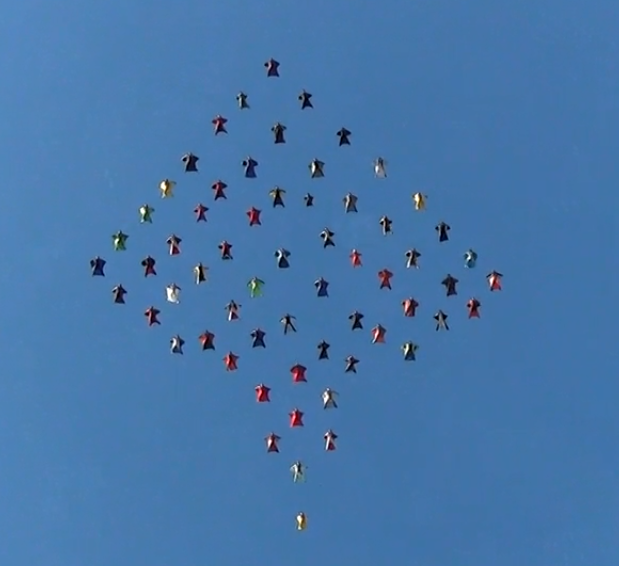kallend 2,230
QuoteQuoteI have lost three friends to canopy collisions - and NONE of them would have been affected by this BSR
proposal. Your point is?
------------------
How many have you lost to hook turns?
Ron
Two. Both had > 1000 jumps, and one flew a large canopy (wasn't a deliberate hook as such, it was a low turn to avoid an obstacle). I also had a guy femur himself right next to me - he had 600 jumps.
The only sure way to survive a canopy collision is not to have one.
skybytch 273
Quotedefine test.
demostrate ability to the ST&A? how? specific skills? (flat turns uphill, downhill, crosswind etc) PRO test? gates? swoop pond? "I've seen you fly your ok"?
will this test be seperate from any licenses? or incorprated into the skills checks? who can sign you off as passed?
again. I am all for guidlines..but let the people on the ground make the decisions about who is qualified and who is dangerous, just as the have been (should be) doing all along..
Here's Derek (hooknswoop)'s proposal -
QuoteThe USPA “A” license card has spaces for certain canopy drills/maneuvers that must be performed prior to getting an “A” license. Until these maneuvers are completed, the skydiver is limited to jumping with a Coach, an Instructor, or solo. This is a positive change from the old “A” license requirements, which were limited to accuracy requirements. USPA recognized the need for additional initial canopy training. Once the “A” license is complete, the only additional license requirements for canopy control is accuracy. The 1-20 jump canopy training gap was identified and fixed at the drop zones that use the ISP program. This was a good start. Unfortunately, not all drop zones utilize the ISP program and continually fail to teach basic canopy skills.
There is a canopy training void in the 20-plus jump range that has been identified, but has not been fixed. Skydivers are downsizing faster to higher wing loadings and higher performance canopies than ever before. Peer pressure, the desire to "fit in" and be "cool", are strong motivations to downsize and execute high performance landings. A few drop zones offer more advanced canopy training schools, but these are purely voluntary and limited in impact to those that attend the course.
I propose USPA develop a series of canopy skills requirements for the “B”, “C”, and “D” licenses that build upon the initial "A" license canopy skills. These requirements would need to be flexible enough to allow for aggressive canopy pilots and conservative canopy pilots alike. They would include canopy control classroom training, practical exercises, a written and practical test. I also propose USPA implement (grandfathering in current license holders), canopy type/wing load restrictions based on the “A” through “D” license. As each license is obtained, the skydiver may jump higher performance canopies. These restrictions would have to be well researched, taking into account canopy type, landing altitude, wing loading, etc. The canopy matrix restrictions could be waiver-able to a certain, defined degree to allow a skydiver that wishes to advance more quickly, puts in the effort, and demonstrates the ability. A skydiver could also earn a canopy restricted "B" through "D" license if they choose not to demonstrate the proficiency required for the next license, in the same manner and similar to those restricted 'D' licenses for those unwilling or unable to perform night jumps.
When the USPA implemented the “A” license canopy skills requirements, they correctly determined that Instructors were qualified to teach these basic canopy skills, without the need for further training or certification of the Instructor. As a skydiver progresses through their skydiving careers, their initial Instructor who taught them basic canopy control skills may not be qualified, or have the skills to teach more advance canopy control without further training for the original Instructor.
Therefore, I further propose the creation of the Canopy Instructor (CI) rating. This rating would be similar to the Coach rating. Whereas the AFFI/ SLI/Coach rating courses focus on free-fall skills and instruction, the CI rating would focus on canopy skills and instruction. A one or two-day course where a Canopy Instructor Candidate learns how to teach more advanced canopy control. Each candidate will be required to demonstrate the ability to perform and teach advanced canopy control skills. A thought would be to simply add canopy piloting skills and canopy instruction skills to the current I rating courses. This brings up the dilemma of a great free-fall Instructor and flyer that can’t fly a canopy or teach canopy piloting very well not being able to teach free-fall skills, what a waste. Also, a CI would not be working with pre “A” license students, but licensed skydivers, and don’t require the free-fall skills and teaching ability to teach advance canopy skills. So the CI rating would be similar to the Coach rating, except focusing on canopy skills, not free-fall skills.
One solution would be to simply add canopy piloting skills and canopy instruction skills to the current Instructor and Coach rating courses. However, this raises the serious dilemma of an exceptional free fall instructor that is a poor canopy pilot and teaches basic canopy piloting well not being allowed to teach his forte, which is free fall skills. Therefore, the only solution I can see is a creation of a separate rating for canopy control instruction. As a CI would not be working with pre-A license students, but only those who have already earned their "A" licenses; and therefore it would not require advanced free-fall skills, simply the ability to teach advanced canopy skills.
I think that Brian Germain's wing loading guidelines is a good place to start for canopy wing loading 'caps':
# Jumps Maximum Wing loading
100 1.1:1
200 1.2:1
300 1.3:1
400 1.4:1
500 "D" License, unlimited
Skills covered for each license:
High performance malfunctions
Flat/Flared turns
Collision avoidance/flying in traffic
Sliders (Kill line, stowage, etc)
Accuracy skills
Basic Principles of Flight
Recovery Arc
Effects of wing loading
Canopy Maintenance
Adjusting Steering Line Length
Preventing and Curing Line Twists
Canopy Piloting Skills
Long Spot Techniques
Flying in Turbulence
Dealing with Traffic
Approach and Landing
Accuracy
Off DZ landings
Crosswind/downwind landings.
For each license, each topic will be covered more in-depth, building upon prior teaching and experience.
Michele 1
Quotecome up with some guidelines for a standard class, and some publicity so that everyone, at every DZ, will have the opportunity in front of them to understand why it's important, I'll help.
Sorry I didn't do better before, but here is an admittedly lame attempt at setting out some thoughts about a ground class...
May 30 post
How about starting somewhere, and developing something which will work from there? A video is a good idea...and there already are several. But you don't learn from watching a vid...you learn from doing. Can a vid be incorporated into the above ideas? Absolutely. However, there needs to be more "doing", I think, as well as "watching". So incorporate the vid into a ground class, and set out a series of manuvers which are mandatory to be able to demonstrate prior to getting your "A" license?
There would be several advantages to making it "mandatory", and that is:
1. Removes the peer pressure from it (hey, I gotta do it before I get my license)
2. Teaches the person before they are generally financially able to purchase gear which gear would be more appropriate to their level.
3. Allows a mentor relationship to begin.
Ask Skyslut about Skydive New England's procedures. They seem to be doing something along the order of what I am talking about, and it seems to answer some of the questions. If it works for them, why not take the basics from there and expand it outward, make it "standard", and encourage all DZ's to use them?
Ciels-
Michele
~Do Angels keep the dreams we seek
While our hearts lie bleeding?~
kallend 2,230
QuoteQuoteYour point is?
My point? Many of us have seen far too many landing accidents. They aren't pretty whether they result in death or "only" injuries. Seems like many of those who haven't seen a few people fuck themselves up are more likely to protest the idea of mandatory training to fly more aggressive canopy types and wingloadings.
How does this relate to jump numbers and wing loading, as opposed to personality type and testosterone poisoning? I've had 5 friends die due to canopy incidents in the last 2 years, and not one of them would have been prevented if this proposal had been in force, since 4 had >500 jumps and the other was flying at 1:1.
What % of canopy fatalities are male and how does it compare with the overall % of males in skydiving?
What % are Type A personalities?
What % are aged 25 or under?
What % were high school athletes, and what % couch potatoes?
How do you know that WL and jump numbers are the most relevant variables here?
The only sure way to survive a canopy collision is not to have one.
Zenister 0
QuoteQuoteYour point is?
My point? Many of us have seen far too many landing accidents. They aren't pretty whether they result in death or "only" injuries. Seems like many of those who haven't seen a few people fuck themselves up are more likely to protest the idea of mandatory training to fly more aggressive canopy types and wingloadings.
if you live at the race track your likely to have seen a few more car wrecks. Witnessing an accident (in any environment) is a lesson that death and pain are a part of life and that education and training can help prevent it from happening to you..if you cant get that lesson from your life experience, then to bad, but that is a poor excuse to regulate those who can...
everyone focuses on the failures..how many successes are there? how many people are currently or were before successfully jumping canopies "ahead of the curve" without incidents? even of those who had incidents while ahead of the proposed restrictions how many can be attributed to simple mistakes (that can and will happen to anyone) and how many are attributable to "insufficient experience under that wing"?
where are the real, solid numbers that can be used to support the position that more people under 500 jumps are dying at high WL than are flying them successfully?
Those who fail to learn from the past are simply Doomed.




My point? Many of us have seen far too many landing accidents. They aren't pretty whether they result in death or "only" injuries. Seems like many of those who haven't seen a few people fuck themselves up are more likely to protest the idea of mandatory training to fly more aggressive canopy types and wingloadings.
Share this post
Link to post
Share on other sites